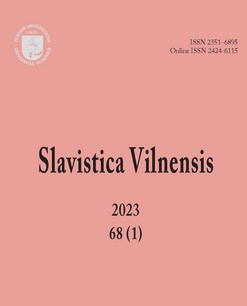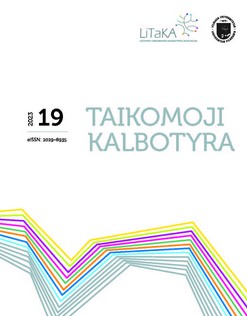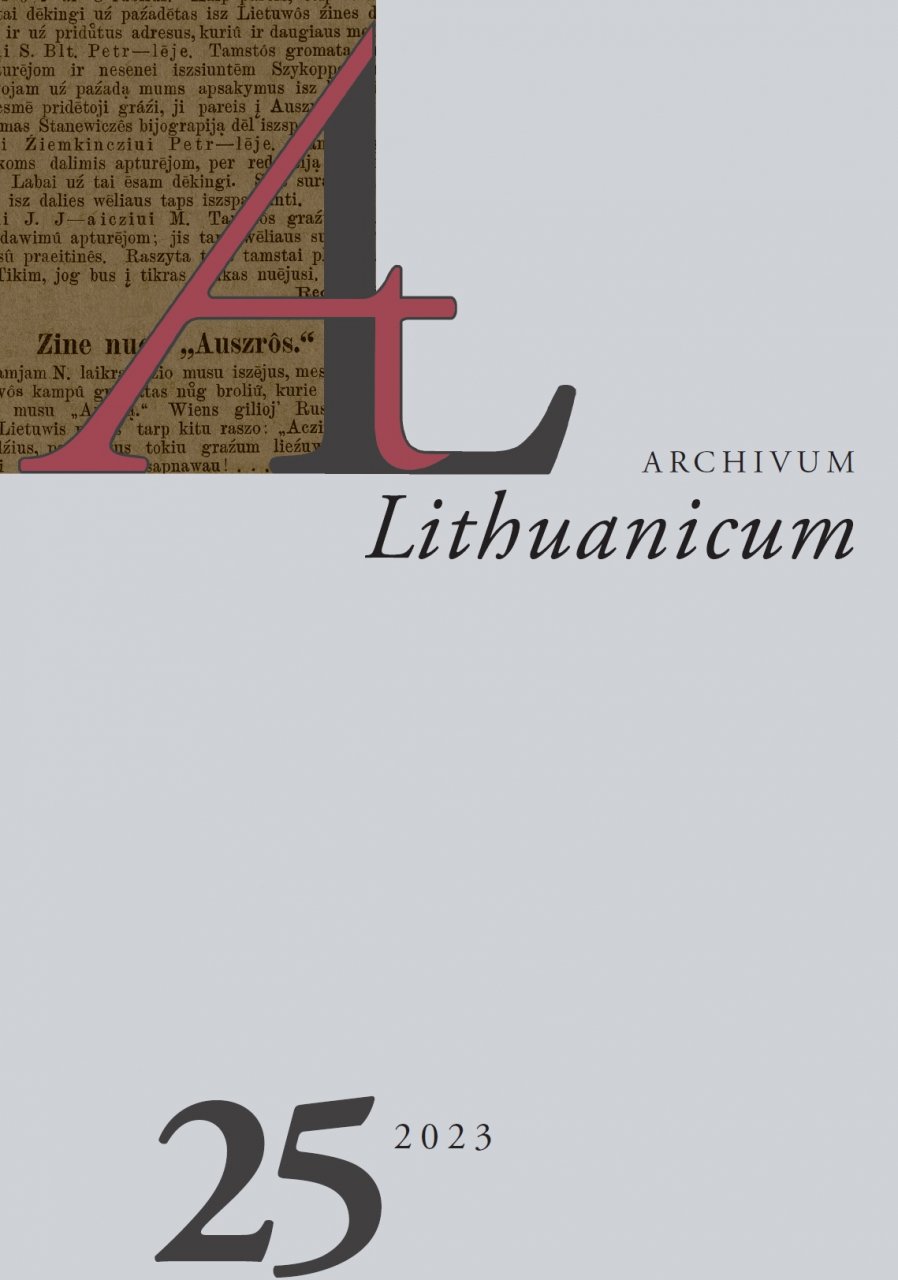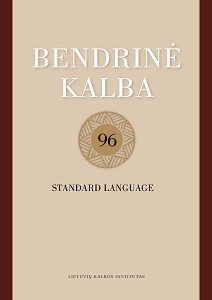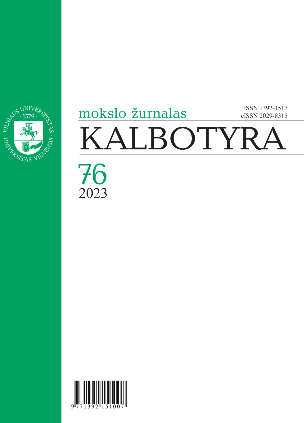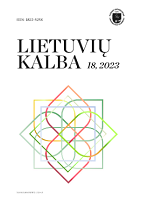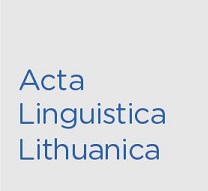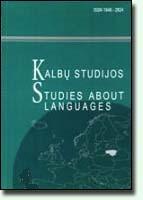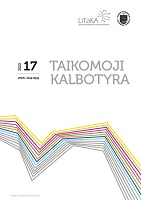Author(s): Rolandas Mikulskas / Language(s): Lithuanian
Issue: 18/2023
The article deals with inceptive constructions in Lithuanian in a systemic way. In the article a thorough overview of eighteen Lithuanian verbs taking infinitives as their complements is given. They are (given in the preterital form): pradėjo, ėmė (‘started’; ‘began’); puolė, šoko, metėsi (orig. ‘rushed at, to’; ‘jumped forward’); suskato, suskubo, sukruto, subruzdo, sujudo (orig. ‘stirred’; ‘moved’; ‘bustled up’); prapliupo, pratrūko (orig. ‘burst’; ‘broke open’; ‘gushed’; ‘spouted’), pasiuto and (synonymous with it) pašėlo (orig. ‘went mad’; ‘got furious’); leidosi, pasileido (orig. ‘let, allowed, permitted oneself’); griebėsi (/ griebė), kibo (orig. ‘grasp’; ‘get hold of’). When used in a construction with the infinitive, these verbs serve the grammatical function of inceptive markers designating the beginning (or start) of an infinitival event. They thus belong to the family of so-called phasal verbs, and the constructions they underlie are phasal constructions. They are, however, scarcely recognized as such (maybe except for the pradėjo and ėmė constructions with infinitive) in traditional Lithuanian lexicography. A construction grammar approach to the phenomenon of the phasal complementation allows us to treat the inceptive constructions under discussion uniformly, as members of the same grammatical category, and the verbs mentioned above, when serving as inceptive markers of the infinitival event, can reasonably go under separate senses in dictionary entries, especially in the cases when the inceptive constructions these verbs underlie are well entrenched in language usage. As inceptive markers, the verbs listed above are in different stages of grammaticalization. As can be seen from their original meanings, these inceptive markers were grammaticalized from various lexical sources (resp. source constructions). Many of them still preserve, to a different extent, a vestige of the previous meanings they had in the source constructions. For instance, the inceptive markers puolė, šoko, metėsi, leidosi, pasileido are, in some syntactic contexts, still reminiscent of motion verbs. Accordingly, the range of lexical types of infinitival complements such a “semi-grammaticalized” inceptive marker selects for is to some degree determined by its inherited semantics (backward pull; Traugott 2008, 34). Or, to put it in other words, the inceptive constructions headed by such verbs form their own specific designation zones, or niches (they can overlap more or less, according to the semantic similarity of the head verbs). It goes without discussion that the main inceptive markers in Lithuania are the verbs pradėjo and ėmė: they are the most desemanticized lexemes in the list and can have the widest range of lexical types of infinitives as their complements. Both of these verbs can designate the beginning of not only voluntary but involuntary infinitival events as well. The remaining verbs in the list mostly presuppose agentive, intentional referents as their subjects. Exceptions here are the verbs prapliupo, pratrūko and pasiuto, pašėlo which designate the beginning of spontaneous, uncontrolled events. Except for pradėjo and ėmė, which are indifferent in this respect, other inceptive markers in the list designate the beginning of intensive, energetic infinitival events. According to their inherited semantics (or the semantics developed in the course of grammaticalization) all inceptive markers in the list can be divided into minor groups. The members of these groups, with respect to infinitival complementation (resp. designation tendencies) share with each other one or another common feature. From a cognitive linguistics perspective all these head verbs can be seen as members of the same grammatical category (that of the inceptive markers) interconnected with each other in a network according to the principle of Ludwig Wittgenstein’s (1958) family resemblances. The fact that in some neutral contexts these verbs can, in their inceptive function, be used interchangeably, gives us empirical grounds to state that the corresponding inceptive constructions share the same schematic meaning. This fact, following William Croft’s (2001, 18) conventions, can formally be represented as a form-meaning pairing: [[HeadV CompVINF] [process inception]]. Of course, the schematic meaning of the category of inceptive constructions is best instantiated by its prototypical members headed by the verbs pradėjo and ėmė. These verbs, correspondingly, take the highest position on the prototypicality scale of the inceptive markers. As the semantic analysis of the data in the samples compiled from the Corpus of Modern Lithuanian shows, even the inceptive constructions headed by the same verb represent different stages of grammaticalization. For example, even some constructions of the verb puolė with infinitive (as a quantitative analysis of the Corpus data shows, this inceptive marker takes third place on the prototypicality scale, just after the verbs pradėjo and ėmė) may be, without sufficient context, ambiguous between intentional and inceptive readings, the former being inherited from the source construction. The probability of the intentional reading is higher when the verb (which happens rarely) selects for the perfective infinitive, but in some cases such a reading is still an option in the default cases of the construction when the verb selects for the imperfective infinitive. From the emergent grammar (Hopper 2011, 26–29) perspective, adopted in the article, all such “semi-grammaticalized” cases in the samples can reasonably be seen as instantiations of the category of inceptive constructions along with its more grammaticalized instances. In overviewing in detail the semantic distribution of the inceptive markers in the list, each within the group of its closest semantic allies, an attempt was made to establish their source constructions and to trace their potential paths of grammaticalization. For instance, the verbs puolė and šoko are originally typical motion predicates designating rushing at, to or jumping forward (from the rest position) of the subject referent. Correspondingly, the source constructions of the inceptive constructions headed by these verbs are motion constructions and, importantly, their structural extension with infinitive gives rise to purpose constructions, where the added infinitive expresses the purpose of the motion. The latter could easily be reanalyzed into the corresponding inceptive constructions. Naturally, the verbs puolė and šoko first of all develop their inceptive marker function in the construction with infinitives designating quick and energetic movement, such as running, pursuing, or chasing. The next stop on the path of grammaticalization of the inceptive constructions these verbs underlie is when their infinitival complements designate events that imply motion (for example, puolė ieškoti (ko nors) ‘started (lit. rushed) to search (for somebody or something)’) or just presuppose it. In the latter case, in the frame of the infinitive, a motion of the subject referent towards the place where she starts (or intends to start) the infinitival event is presupposed (for example, Jis puolė (ką) mušti ‘He started (lit. rushed) to beat (somebody)’). In all these cases the inherited motion component in the semantics of the head verbs of the inceptive constructions is supported by the very semantics of its infinitives, it is more or less present. In the routine of usage, though, this presupposed motion of the subject referent towards the destination can easily be conceived subjectively by the speaker (/ hearer) (when she covers the distance only in her mind). Through this cognitive mechanism, called subjectification by Ronald Langacker (2000, 297–315), the motion component in the semantics of the head verbs is backgrounded and, respectively, their grammatical function (that of the inceptive markers) is foregrounded. Thus, in the constructions of this kind their head verbs, originating as the motion predicates, are prepared to take as their infinitival complements lexical types that have nothing to do with the concept of motion. For instance, they can designate the beginning of the verbal event, as in Ji puolė jo klausinėti ‘She started to interrogate him’. Such instances represent the last stage of the grammaticalization of the inceptive markers under discussion. As it is revealed in the article, subjectification took part in the processes of grammaticalization of some other Lithuanian inceptive marker as well. In this respect other cognitive devices, such as conceptual metaphor or / and metonymy, are also worth mentioning. For instance, they played a significant role in the adaptation of the verbs prapliupo and pratrūko, originally designating phenomena of the physical world, to designate outburst of some emotion, such as joy (for example, Ji prapliupo juoktis ‘She began (lit. burst) to laugh / laughing’), sadness (for example, Ji pratrūko verkti ‘She began (lit. burst) to cry / crying’) or anger (for example, Jis prapliupo keiktis ‘He began (lit. burst) to swear / swearing’). In the article the judgments about the entrenchment of the Lithuanian inceptive markers in the language usage were substantiated by quantitative analysis of the data extracted from the Corpus of Modern Lithuanian (one may reasonably assume that the entrenchment of such functional words is indicative of their grammaticalization). These judgments, as was mentioned above, are of importance for lexicographical practice. The samples for the quantitative analysis were mainly compiled from the fiction register of the Corpus that is in many respects reminiscent of the spoken language. In some cases, though, the relevant data from the mass media register of the Corpus were added. For these samples only inceptive constructions with preterital forms of their head verbs were picked out from the register (or registers), as they are assumed to be the most representative of the narrative contexts characteristic of the Corpus. The judgments on the entrenchment of the inceptive markers were mainly based on the number of hits of the constructions they underlie in the register. Additionally, in some cases the productivity indexes for the corresponding construction types were calculated. The productivity index consists of the number of hapaxes (lexical types of infinitival complements that occur only once in the sample) divided by the total number of those lexical types here — it characterizes the extensibility of the construction type. Thus understood, the productivity of the construction type is expected to correlate with the entrenchment of its head verb in language usage. Because of the lack of the data in the Corpus, though, in most cases (except for the inceptive constructions headed by the verbs pradėjo, ėmė and puolė) one cannot compile reliable samples from the same and a sufficient number (for example, 100) of running lines featuring the construction types under discussion, so as to get productivity indexes for these construction types that might have comparability value. So, in the judgments on the entrenchment of the inceptive markers the productivity indexes for the corresponding construction types played only a subsidiary role in most cases.
More...
